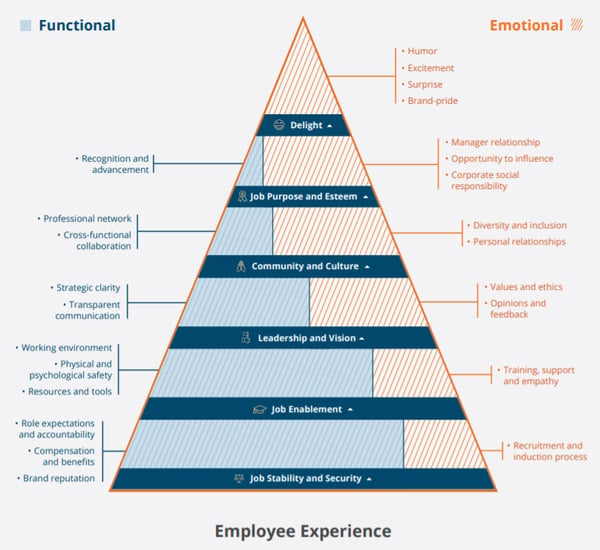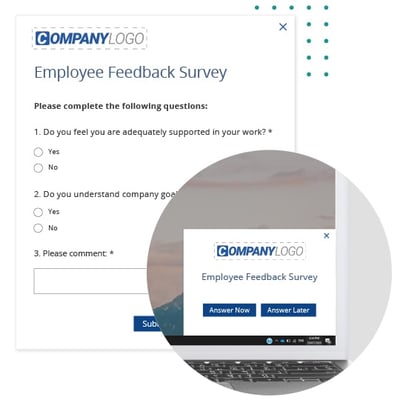
Every year 550 million workdays are lost in the US due to workplace stress. That places a huge burden on both employee health and business productivity.
Stressed employees don’t function at their full potential. And absent employees can’t contribute to business performance.
Exhaustion, loneliness, irritability and job disengagement are typical signs of job burnout. These have been exacerbated by the COVID pandemic. More than four in 10 US adults had increased anxiety levels by the end of 2020, according to The Wall Street Journal, a sharp increase compared to the first half of 2019.
As businesses enter the new post-COVID world of work, addressing this issue will be critical. While employee burnout may be an all-too-common hallmark of working today, it is avoidable. Managing the causes of burnout and job fatigue, and introducing solutions, begins with recognizing the impact.
1. The Impact
Stress can dominate personal and professional life if unaddressed. In the workplace, it can result in employees disengaging with the company and their role.
Research shows that companies without systems to support employee wellbeing have higher turnover, lower productivity and higher healthcare costs. Workplace stress is estimated to cost the US economy more than $500 billion dollars each year.
Attrition rates are a leading indicator of burnout. Employees with sustained high levels of stress and fatigue are likely to see leaving the company their only option. They feel neither equipped nor supported to remain and resolve the issue.

A study by the American Psychological Association (APA) reveals that burned-out employees are 2.6 times more likely to actively seek a different job, and 63% more likely to take a sick day.
The numbers prove that employee burnout has a very real cost to organizations. But what are the causes – and how can HR managers and employers resolve them?
2. The Causes
Job burnout is the result of a number of factors. A survey by Gallup found the main causes to be:
- Unfair treatment at work
- Unmanageable workload
- Lack of role clarity
- Lack of management communication and support
- Unreasonable time pressure
The disrupted working environments caused by COVID-19 have heightened these factors by blurring the distinction between employees’ home and work lives. Where once the home was a haven from the pressures of work, today’s remote working and 24/7 availability undermine this.
The capacity for working at any time implicitly encourages employees to do so, resulting in 10-12 hour working days being commonplace. As well as increasing working hours, it also lessens their ability to compartmentalize it. Essential downtime is neglected.

SnapComms research into employee experience (EX) defines six core components to positive EX. The absence of any of these can contribute to burnout. The six components, and how they relate to employee burnout, are:
1. Job stability and security
Unclear job expectations and processes are a primary contributor to burnout. “What does my work offer me?”
2. Job enablement
Inadequate training, tools, support and safety undermine employees’ ability to do their jobs. “Am I best equipped to do my role?”
3. Leadership and vision
Lack of leadership visibility and transparency reduces connection with the company. “How does this company align with my values?”
4. Community and culture
Feeling isolated, inefficient and excluded increases the propensity for burnout. “Do I feel connected to this company?”
5. Job purpose and esteem
Poor recognition, relationships and rewards all contribute to disengagement. “Does my work fulfill me?”
6. Delight
Repetitive, humdrum environments make work a chore and undermine EX. “Do I love my job?”
3. The Solutions
Recognizing how important the issue is, many organizations have taken steps to address and prevent burnout and fatigue in the workplace. Consider the areas below to see whether your workplace is set up to banish burnout – or increase it.
1. Time Management
Task and deadline pressure are one of the leading causes of experiencing burnout. Demands of their role make staff feel forced to work longer and harder, contributing to stress levels. Working long days every day isn’t a badge of pride. Burning the candle at both ends is a recipe for burnout.
Sensible time management isn’t a new concept. But it’s even more salient in today’s world of global workplaces and remote working. Promote healthy, considerate practices, such as not scheduling meetings in employees’ personal time or lunch break. Introduce Zoom-free Fridays. Assess which meetings staff must attend versus those that are nice to know.
Action: Educate staff on etiquette around meetings and respect of personal time. Ensure team leaders are leading by example. Encourage managers to work with employees to set realistic delivery timeframes for their work – not everything is ‘needed yesterday’.
2. Give Employees a Voice
Frustration and disengagement grow when employees don’t feel their opinions are heard. One of the most effective solutions is simply to ask employees what they want/need. Don’t presume to know what they want without asking!
This can be achieved through staff surveys or digital ‘suggestion boxes’ on your corporate intranet. Members of the leadership team could be encouraged to speak with staff during regular walks around the office, warehouse or wherever.
Action: Identify the areas for which you want insights and circulate an online staff survey. Construct the questions to allow for easy analysis and drilling down by department, location or role type. Feed back the results and action points to staff ASAP afterwards.

3. Employee Empowerment
Loss of situational control is a big driver of stress and burnout. Employees should have some feeling of control over their jobs. This builds engagement, enhances personal recognition, increases investment in successful outcomes, and fosters a passion for the job.
Achieving this comes partly from employees taking ownership of their role and how they perform it, and partly from employers setting an expectation that this is encouraged. Employees will only act within the boundaries of what employers have established, so reducing burnout requires active involvement from both parties.
Action: Review role responsibilities with each employee. Work together on setting reasonable priorities. Assess where flexibility in delivery could accommodate their personal working style.
4. Focus on Wellbeing
Work is stressful, even under normal conditions. But the unique demands and restrictions of remote working and social isolation during COVID have only added to this. Employers play an essential role in helping employees deal with issues of stress, anxiety and burnout in these times.
Internal communications should raise awareness around workplace wellness and provide the tools and resources to improve it. Promote workplace safety and work-life balance by arranging sessions with motivational speakers or nutrition experts. Ensure employees are aware of the EAP services and external support available to them.
Action: Reinforce key messages through eye-catching corporate screensavers or on-site digital signage channels. Remind staff of the basics (taking breaks, stretching, hydration, exercise, etc.).
5. Strengthen Relationships
You’ve probably heard the saying that employees don’t leave organizations, they leave managers. While that’s rarely the full story, a breakdown in the employee-manager relationship is a key contributor to burnout.
Better line management means keeping in touch with employees. Finding out what support they need and truly understanding how they’re coping with workload and other pressures. It’s not a witch-hunting exercise, but an investment into a more genuine supportive relationship.
Action: Establish a process of regular check-ins between employees and line managers (at least fortnightly). Talk through their progress, their frustrations and their successes. Provide support where required and keep abreast of particular areas of concern.
6. Build a Welcoming Workplace
As staff begin returning to the workplace after COVID, a positive working environment is essential. It redresses a common cause of employee burnout and helps rebuild workplace morale. 65% of employers claim that employee morale has been a problem during the pandemic.
Back to business doesn’t just mean a return to the old ways. Consider the opportunities for improving efficiency and collaboration a reopened office allows. Introduce breakout spaces and pods for informal meetings. Incorporate bright colors and plentiful space to inspire fresh thinking.
More importantly, foster an environment where employees feel they can ask questions and take concerns to managers or the HR team.
Action: Audit your current workplace setup. What improvements can be made to increase its appeal, over and above the health and safety precautions being taken? How can some of the working from home environment be incorporated (such as bringing pets to work)?
Addressing employee burnout and fatigue must be a priority for Human Resources Managers this year. Focus messaging on how to form healthy mental habits and establish a positive working environment.

Download: Employee Wellness Guide
Get the guide for six tactics to improve employee wellness and how to achieve these through your communications.



